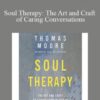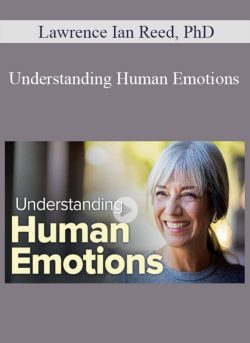$169.00 Original price was: $169.00.$51.00Current price is: $51.00.
Digital Download: You will receive a download link via your order email
Save up to 85% compared to Salepage prices. In addition, earn additional points. Save more on your next order.
Please contact email: esygbteam@gmail.com if you have any questions about this course.
 Purchase this course you will earn 51 Points worth of $5.10
Purchase this course you will earn 51 Points worth of $5.10Elevate your skills with the Lawrence Ian Reed, PhD – Understanding Human Emotions course, available for just $169.00 Original price was: $169.00.$51.00Current price is: $51.00. on Utralist.com! Browse our curated selection of over 60,000 downloadable digital courses across diverse Everything Else. Benefit from expert-led, self-paced instruction and save over 80%. Start learning smarter today!
 Lawrence Ian Reed, PhD – Understanding Human Emotions
Lawrence Ian Reed, PhD – Understanding Human Emotions
Lawrence Ian Reed, PhD
Emotions color our cognitive processes and shape our social relationships. Discover a newfound appreciation for those feelings that underscore the most important moments of your life.
InstitutionNew York University
Alma materUniversity of Pittsburgh
Course Overview
While we as humans have developed significant physical adaptations for our survival and success, there are some crucial adaptations we often overlook. Physical attributes—walking on two legs, opposable thumbs, stereoscopic vision, complex vocal cords, and more—don’t completely explain our species’ success. While many of us would instead point to the human brain, and the resulting human mind, as our most significant adaptation, we actually have astonishing adaptive features that are often overlooked: our emotions.
Our emotions are vital tools in our arsenal of adaptions, ones that we rarely consider or appreciate as a survival mechanism. Some of us might even label emotions as negative or feel they do nothing but get in our way. But from a scientist’s perspective, our emotions are methodic, purposeful, and intelligent.
In the 12 fascinating lectures of Understanding Human Emotions, Professor Lawrence Ian Reed helps us consider emotions from an evolutionary point of view—exploring why we have these consistent feelings and physical responses to specific stimuli in our lives and how they benefit us. That doesn’t mean we feel great when a moment of jealousy pops up or that we should be thrilled to be angry. It does mean that, averaged over the course of evolutionary history, our emotions motivate us to act in ways that best promote our survival and reproduction. Without the full range of our emotions, we simply would not be here.
What Exactly Are Emotions?
We all know what emotions are and yet we find them so difficult to define. We experience them and recognize them in others every single day. At some stages in life, we might even feel controlled by our emotions. Some people claim they try to rise above their emotions and live by reason alone. But what are emotions?
It’s not an easy question, and one that philosophers and scientists have been wrestling with for millennia. In this course, you’ll learn about many of the earliest written musings on the subject, including those of:
- Aristotle. The Greek philosopher offered some of the first systematic analysis of emotion in the 4th century BCE. In his book Rhetoric, he wrote that emotions depend upon what we believe and our judgments of events in the world.
- Charles Darwin. In his 1870 book, The Expression of the Emotions in Man and Animals, biologist Charles Darwin argued that emotional expressions came from habits that were useful in our evolutionary past.
- William James. The work of 19th century American philosopher and psychologist William James led to the idea that our experience of many emotions involves changes in the autonomic nervous system.
In the second half of the 20th century, the scientific study of emotions came into its own in the brain sciences, psychology, and other social sciences, such as sociology and anthropology. Today, we recognize that emotions can be thought of in computer terms: as superordinate programs that coordinate subprograms in order to motivate adaptive behaviors. In this way, emotions function from an evolutionary perspective as solutions to recurrent problems faced by our ancestors over the course of history.
Emotions and the Body
If emotions are superordinate programs coordinating a variety of subprograms to motivate adaptive behavior, what are these subprograms and how do they help us?
Consider the ancient ancestor who unexpectedly finds himself much closer to a tiger than he ever wanted to be. As his emotion of fear kicks into high gear, hormones surge through his system to prepare him to fight, flee, or freeze. None of those options might be enough to save this particular man in that moment. But without that hormone surge, what would he be doing? He might have reached down to leisurely scratch that mosquito bite on his ankle, started daydreaming, or realized that he was hungry. None of those actions or thoughts would have helped preserve his life in any way. Without the benefit of fear, that man would not have had a chance.
In Understanding Human Emotions, you’ll learn about the many bodily functions that are affected by emotions. In addition to the “butterflies in your stomach” and nervous sweating that you might have experienced, you’ll learn about:
- Glucose. The release of cortisol into the bloodstream activates glucose production, which is needed for metabolically expensive actions such as running or fighting.
- Blood flow. Blood flows freely to the hands when we’re angry, in order to prepare us for combat, but it remains in the chest when we’re afraid, to support flight.
- Hunger. No matter how hungry you are, that feeling will evaporate at the sight or smell of food that could be contaminated or harmful, thanks to the protective emotion of disgust.
Cultural Component of Emotions
While scientists believe all humans have the same emotional potential, the way in which emotions are expressed and perceived can depend on a person’s culture and associated values. In general, in cultures that place a high value on self-expression, emotions are understood and expressed differently than in cultures that place greater value on knowing one’s place within a larger society.
One of many fascinating studies you’ll learn about in this course is the comparison of responses given by American students of European heritage and responses given by American students of Asian heritage. Although both groups had similar physiological responses to remarks of a rude instructor that commented on their mistakes while they were doing a stressful task, the European American students expressed more visible anger than the Asian American students. One interpretation of this difference would be that spontaneous emotional expressions are valued more highly in Western European cultures, since they are a means to express the individual’s authentic self. And in contrast, the Asian American students were more likely to constrain their expression of anger because angry expressions risk disrupting social harmony, a disruption frowned upon in many Asian cultures.
In this course, you’ll learn about cultural differences in the experience and display of many emotions, including:
- Anger. While public expressions of anger are encouraged in some societies—such as the Ilongot people of the Philippines and the Yanomamo of South America—in other societies, such as the Inuit people of North America, anger seems to rarely occur.
- Shame. In Western cultures, shame is seen as damaging and is to be avoided. But in more hierarchically structured societies, shame seems to be more valued, especially when the shame is experienced by a person of lower status.
- Excitement.Some cultures view excitement as a pathway to happiness, while others view it as the road to calmness and serenity.
While the evolutionary and cultural perspectives of emotion do find different expression in different cultures, the two perspectives have much in common, especially the idea that emotions promote cooperation, which is always a critical factor for the survival of a species.
12 Lectures
Average 26 minutes each
Delivery Method
Cultivate continuous growth with the Lawrence Ian Reed, PhD – Understanding Human Emotions course at Utralist.com! Unlock lifetime access to premium digital content, meticulously designed for both career advancement and personal enrichment.
- Lifetime Access: Enjoy limitless access to your purchased courses.
- Exceptional Value: Benefit from savings up to 80% on high-quality courses.
- Secure Transactions: Your payments are always safe and protected.
- Practical Application: Gain real-world skills applicable to your goals.
- Instant Accessibility: Begin your learning journey immediately after buying.
- Device Compatible: Access your courses seamlessly on any device.
Transform your potential with Utralist.com!
Related products
Everything Else
= 45 Points
Everything Else
= 47 Points
Everything Else
Jacob Sokol – Quadruple Your Coaching Biz 19 expert sessions
= 43 Points
Everything Else
= 81 Points
Everything Else
= 38 Points
Everything Else
= 56 Points
Everything Else
= 43 Points
Everything Else
= 43 Points




 Lawrence Ian Reed, PhD – Understanding Human Emotions
Lawrence Ian Reed, PhD – Understanding Human Emotions







